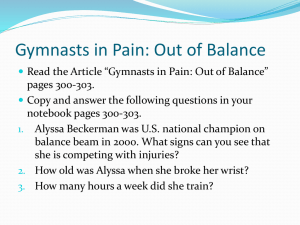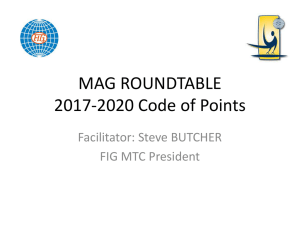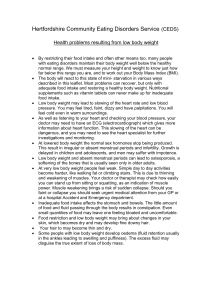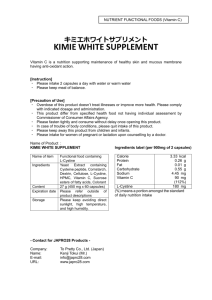Advance Journal of Food Science and Technology 8(1): 85-87, 2015
advertisement
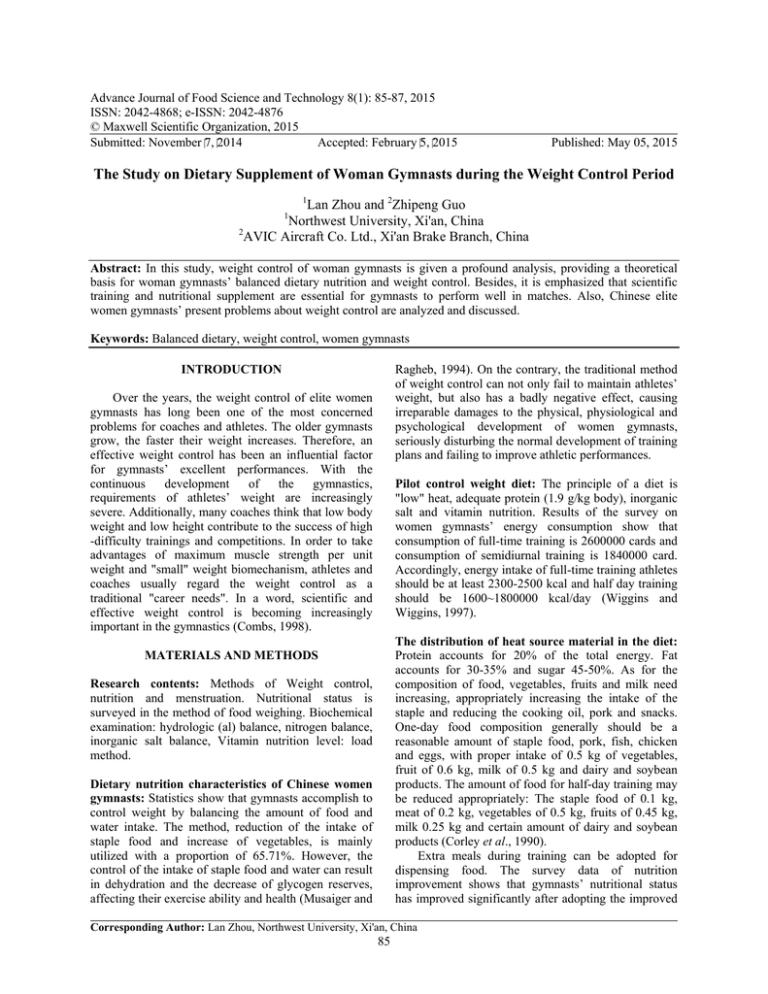
Advance Journal of Food Science and Technology 8(1): 85-87, 2015 ISSN: 2042-4868; e-ISSN: 2042-4876 © Maxwell Scientific Organization, 2015 Submitted: November 7, 2014 Accepted: February 5, 2015 Published: May 05, 2015 The Study on Dietary Supplement of Woman Gymnasts during the Weight Control Period 1 Lan Zhou and 2Zhipeng Guo Northwest University, Xi'an, China 2 AVIC Aircraft Co. Ltd., Xi'an Brake Branch, China 1 Abstract: In this study, weight control of woman gymnasts is given a profound analysis, providing a theoretical basis for woman gymnasts’ balanced dietary nutrition and weight control. Besides, it is emphasized that scientific training and nutritional supplement are essential for gymnasts to perform well in matches. Also, Chinese elite women gymnasts’ present problems about weight control are analyzed and discussed. Keywords: Balanced dietary, weight control, women gymnasts Ragheb, 1994). On the contrary, the traditional method of weight control can not only fail to maintain athletes’ weight, but also has a badly negative effect, causing irreparable damages to the physical, physiological and psychological development of women gymnasts, seriously disturbing the normal development of training plans and failing to improve athletic performances. INTRODUCTION Over the years, the weight control of elite women gymnasts has long been one of the most concerned problems for coaches and athletes. The older gymnasts grow, the faster their weight increases. Therefore, an effective weight control has been an influential factor for gymnasts’ excellent performances. With the continuous development of the gymnastics, requirements of athletes’ weight are increasingly severe. Additionally, many coaches think that low body weight and low height contribute to the success of high -difficulty trainings and competitions. In order to take advantages of maximum muscle strength per unit weight and "small" weight biomechanism, athletes and coaches usually regard the weight control as a traditional "career needs". In a word, scientific and effective weight control is becoming increasingly important in the gymnastics (Combs, 1998). Pilot control weight diet: The principle of a diet is "low" heat, adequate protein (1.9 g/kg body), inorganic salt and vitamin nutrition. Results of the survey on women gymnasts’ energy consumption show that consumption of full-time training is 2600000 cards and consumption of semidiurnal training is 1840000 card. Accordingly, energy intake of full-time training athletes should be at least 2300-2500 kcal and half day training should be 1600~1800000 kcal/day (Wiggins and Wiggins, 1997). The distribution of heat source material in the diet: Protein accounts for 20% of the total energy. Fat accounts for 30-35% and sugar 45-50%. As for the composition of food, vegetables, fruits and milk need increasing, appropriately increasing the intake of the staple and reducing the cooking oil, pork and snacks. One-day food composition generally should be a reasonable amount of staple food, pork, fish, chicken and eggs, with proper intake of 0.5 kg of vegetables, fruit of 0.6 kg, milk of 0.5 kg and dairy and soybean products. The amount of food for half-day training may be reduced appropriately: The staple food of 0.1 kg, meat of 0.2 kg, vegetables of 0.5 kg, fruits of 0.45 kg, milk 0.25 kg and certain amount of dairy and soybean products (Corley et al., 1990). Extra meals during training can be adopted for dispensing food. The survey data of nutrition improvement shows that gymnasts’ nutritional status has improved significantly after adopting the improved MATERIALS AND METHODS Research contents: Methods of Weight control, nutrition and menstruation. Nutritional status is surveyed in the method of food weighing. Biochemical examination: hydrologic (al) balance, nitrogen balance, inorganic salt balance, Vitamin nutrition level: load method. Dietary nutrition characteristics of Chinese women gymnasts: Statistics show that gymnasts accomplish to control weight by balancing the amount of food and water intake. The method, reduction of the intake of staple food and increase of vegetables, is mainly utilized with a proportion of 65.71%. However, the control of the intake of staple food and water can result in dehydration and the decrease of glycogen reserves, affecting their exercise ability and health (Musaiger and Corresponding Author: Lan Zhou, Northwest University, Xi'an, China 85 Adv. J. Food Sci. Technol., 8(1): 85-87, 2015 Table 1: Heat energy intake The athlete group Large group The small group Survey ------------------------------------------------------------------------------Situation Date To improve before 82-9 After the improvement 83-8 To improve before 82-9 After the improvement 83-8 After the improvement 85-6 Heat energy intake ---------------------------------------------------Kcal/day Kcal/kg/day 1503±331 41.0±9.0 2325±49 58.5±1.2 1940±491 61.0±15.4 2139±123 59.0±3.4 2250±450 51.6±10.3 Table 2: Protein intake The athlete group Large group The small group Situation To improve before After the improvement To improve before After the improvement After the improvement Protein intake ------------------------------------------------------------------------G/day G/kg body weight/day The % of heat 64±23 1.75±0.75 16.9±6 107±12 2.68±0.50 18.8±2 62±13 1.95±0.40 12.7±3 90±7 2.50±0.30 16.3±1 82±27 1.90±0.60 14.1±4 Date 82-9 83-8 82-9 83-8 85-6 diet. According to the survey, the negative balance of inorganic salts gets corrected. As shown in Table 1. As for the food composition, some problems like less staple food and the deficiency of milk and vegetables still remain, which need a further improvement. Needs for minerals and water: Mineral substance, also known as inorganic salts, is an important substance in human tissues and to maintain normal physiological activities. In the process of training, woman gymnasts sweat heavily and sweat contains minerals such as potassium, sodium, calcium, magnesium, iron, copper, iron and selenium which causes the loss of inorganic salt, impairing sports ability and health of athletes. RESULTS AND DISCUSSION Need for carbohydrates: Carbohydrate, one of the most important energy in skeletal muscle in movement, which comes from the conversion of glucose of muscle glycogen and liver glycogen reserves, plays multiple roles in vivo in the form of glycolipids and glycoproteins. Young athletes are in the stage of much manual and mental labor, with 95% of the brain energy required from glucose. So young athletes, with much more physical activities than adults, can easily get fatigue in sports training, having positive effects on the normal training. Needs for vitamin: Vitamin is a kind of organic compound which can adjust human body's normal physiological function and maintain health. For example, vitamin C, a kind of water-soluble vitamin, can strengthen immune ability and help the absorption, transport and storage of iron, which is called antioxidant effect (Nuviala Mateo and Lapieza Lainez, 1997). On the contrary, lack of vitamin C leads to scorbutus. As for athletes, the supplement of a certain amount of vitamin C helps to improve the immune function of organism, relieve fatigue and muscle soreness, enhance sports ability and protect cells against damage from free radicals. What’ more, vitamin B1 involves in glucose metabolism in the form of coenzyme. The more energy consumption increases, the more required vitamin B1 will be. Thus, compared with non-athlete teenagers, woman gymnasts who attend a lot of sports training, consuming much energy, have a higher demand for vitamin B1. Needs for fat: As one of the major energy in movement, fat has the characteristics of high energy density, light in weight and high heat compared to carbohydrate. Also, fatty acids come from triglyceride in adipose tissue. Above all, woman gymnasts are inclined to fat metabolism instead of carbohydrate in long-time exercises when cholesterol level in blood increases significantly. Energy balance: Energy balance is one of an important factors affecting body weight. When a person’s daily intake of calories is more than the calories consumed, excess heat will be converted into fat accumulation in the body, causing weight gain. Conversely, when the daily calorie intake is less than or equal to the daily consumption, excess fat will be consumed or lead to an offset, resulting in the reduction of weight. Needs for protein: Protein, the basic component of cells, is helpful for the growth of such tissues and organs as bone, muscle and viscera etc. In addition, proper intake of protein energy is needed by athletes who will take considerable physical activities and exercise training. So, it is of vital importance for woman gymnasts to take in sufficient protein. Besides, protein intake has aroused people’s concern. According to the research, it is recommended that 12-15% of adults’ daily intake of energy need to be obtained from protein. The protein intakes are as shown in Table 2. Movement characteristics of competitive gymnastics: Athletes require anaerobic exercise with high intensity repeatedly when in training and 86 Adv. J. Food Sci. Technol., 8(1): 85-87, 2015 competition. For a long-time training, glycolysis and ATP-CP are regarded as the main energy source. Duration of a complete set of movement of women's gymnastics and the main energy supply systems are as the following respectively: • • • • properly control the body fat level. But it should be emphasized that controlling weight by dewatering (limiting water intake or taking diuretics) may increase the burden of cardiac, vascular and renal, damaging their athletic ability. Also, the effect will not maintain for a long time. In order to control weight, reducing excess body fat should be mainly focused on, in the method of more exercises and a balanced diet, paying attention to the lowest level of body fat to maintain optimal capacity. Above all, to improve athlete's physique and physical strength, researches about training methods should be emphasized, with the purpose of increasing athletes’ fat-free body weight and improving their diets comprehensively. Horse-vaulting: The duration 5-7 sec The main energy supply system: ATP-CP Uneven bars: The duration 25-30 sec The main energy supply system: glycolysis Balance beam: The duration: 70-90 sec The main energy supply system: glycolysis Free exercise: The duration: 70-90 sec The main energy supply system: glycolysis The weight of the players should not exceed the original weight index according to characteristics of the gymnastics item. Once the standard is exceeded, athletes have to lose weight in the method of fasting, diuretics and diarrhea, which will have a certain effect at that time, with great side effects. Furthermore, the reduction or depletion of glycogen and dehydration as well as the loss of other nutrients lead to various morbidities such as the increase burden of heart and kidney, metabolite accumulation, slow blood flow, temperature adjustment disorder caused by the accumulation of blood backlog, the decrease of hemoglobin, potential imbalance, the internal environment disorder and the plummet of physical activity. REFERENCES Combs, J.A., 1998. Bacterial osteitis pubis in a weight lifter without invasive trauma. Med. Sci. Sport. Exer., 30: 1561-1563. Corley, G., M. Demarest-Litchford and T.L. Bazzarre, 1990. Nutrition knowledge and dietary practices of college coaches. J. Am. Diet. Assoc., 90: 705-709. Musaiger, A.O. and M.A. Ragheb, 1994. Dietary habits of athletes in Bahrain. Nutr. Health, 10: 17-25. Nuviala Mateo, R.J. and M.G. Lapieza Lainez, 1997. The intake of proteins and essential amino acids in top-competing women athletes. Nutr. Hosp., 12(2): 85-91. Wiggins, D.L. and M.E. Wiggins, 1997. The female athlete. Clin. Sport. Med., 16: 593-612. CONCLUSION In order to meet the special needs of high difficulty training and athletic competition, woman gymnasts can 87
